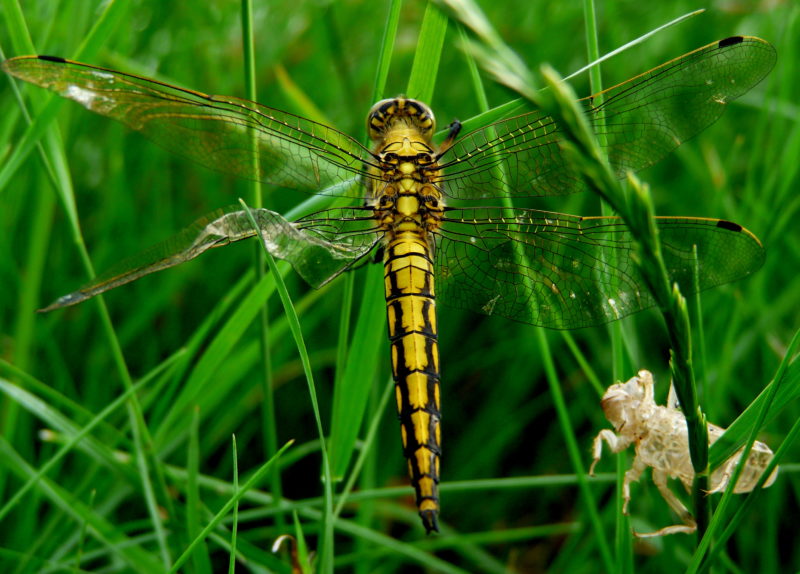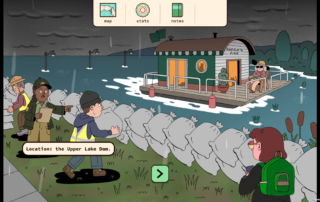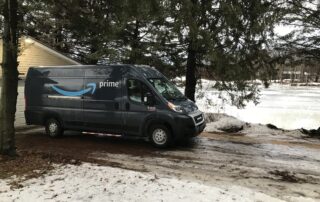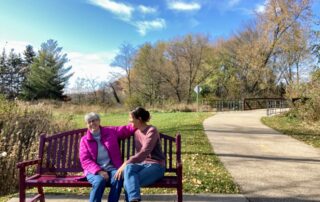Along the Ice Age Trail, near Portage County’s Trunk T, is a short spur that delivers me, chute-like, from the shelter of the forest to a pond. The pond startles with its sudden brightness, its pastels of duckweed and sky.
Today, my birthday, I have the arrival of friends and a celebratory dinner to look forward to, so I must budget my hours, leaving time to bathe, to select appropriate clothing, and to sit through a multicourse meal, ignoring the burn of deerfly bites, one of which will puff out my hand like a baseball glove. I take the spur anyway, as if I had all the time in the world.
I am not alone: nearby the gradually loudening whir of some machine muffles the check of red-winged blackbirds. Soon, three weed-whacking trail-workers appear clad in white protective clothing with serious facemasks. They remind me of a frightening image from childhood—the scientists who invaded the family’s home in Spielberg’s film E.T, who scared me so much more than the alien himself. My dog, jumping wildly through the grass, forces a meeting. I wave to the workers exaggeratedly, a gesture that cuts through the engine noise and says I come in peace. They wave back.
I turn to the pond, notice a dragonfly nymph clinging to a reed. As a naturalist, I taught about this. A child would catch a nymph during pond study, and I’d pull out its long, hooked lower mandible used to scoop up insects on the pond bottom. I’d describe how it grew and molted, explain its climb out of the water up a plant stem, the shedding of the exoskeleton, drying of wings, first flight. But this was all from books, for I’d never witnessed it myself. I see now that I left out all the best parts. I had no idea, really, what I was talking about.
I kneel and all around, dragonflies present various stages of emergence. The nymphs have climbed high, two or three feet up their blades of grass. But their exit is less wriggle than a slow bursting. Time passes strangely; nothing moves, yet much occurs.
Some rest on their exoskeletons, hardening wings displayed horizontally. Some, pale as new buds, hold their wings clasped above, tent-like, pumping hemolymph through them. For many, I can’t tell if things are going well or not: they look a little squashed, malformed, shocked. Their unfolded wings seem amputated; they hang upside down, half-stuck in their exoskeletons, using gravity on their heavy heads—all eyeball—to pull themselves out. I watch one that looks dead. Suddenly, touched by a tiny beetle, it gives a zombie-like shake, startling both beetle and me with its alive-ness.
It’s apparent that much metamorphosis has already happened. Crisp exoskeletons which rain will knock away don the stalks, bodies still in position of the nymph’s final grip, but without an ounce of strength. The back of each is slit, and here is the part I completely missed in my book-reading, teaching days: small, white threads hang out of each exoskeleton. They are the nymph’s respiratory system, the shed cuticles of the trachea that brought air directly to its organs. But they look like clipped, insulated electrical wires, presenting an image both horrific and wonderful, as if the nymphs were actually robots that suddenly came to life, breaking out of artificial bodies to ascend as their true selves.
Dragonfly nymph, trail worker, scientist, civilized dinner guest, dressed in our appropriate garb we navigate what we think is the world as who we think we are. But I’m inclined to believe that inside we are each a bit extra-terrestrial, our beautiful alien selves slow to come forth, yet capable of unimaginable transport.











